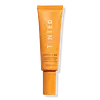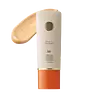What's inside
What's inside
 Key Ingredients
Key Ingredients

 Benefits
Benefits

 Concerns
Concerns

 Ingredients Side-by-side
Ingredients Side-by-side

Zinc Oxide 18.23%
Cosmetic ColorantWater
Skin ConditioningCaprylic/Capric Triglyceride
MaskingC13-15 Alkane
SolventPropanediol
SolventC15-19 Alkane
SolventBis-Diglyceryl Polyacyladipate-2
EmollientTocopherol
AntioxidantOctyldodecanol
EmollientPolyhydroxystearic Acid
EmulsifyingInositol
HumectantHippophae Rhamnoides Oil
EmollientSilica
AbrasivePolyacrylate Crosspolymer-6
Emulsion StabilisingIsostearic Acid
CleansingLecithin
EmollientPolyglyceryl-3 Polyricinoleate
EmulsifyingXanthan Gum
EmulsifyingCoco-Glucoside
CleansingPolyglycerin-3
HumectantPolyglyceryl-3 Lactate/Laurate
CleansingBisabolol
MaskingCaprylhydroxamic Acid
Sodium Dilauramidoglutamide Lysine
HumectantSodium Citrate
BufferingCitric Acid
BufferingArachidyl Glucoside
EmulsifyingSodium Phytate
Glycerin
HumectantPhysalis Alkekengi Calyx Extract
Skin ConditioningBiosaccharide Gum-1
HumectantSodium Levulinate
Skin ConditioningGlyceryl Caprylate
EmollientCetearyl Alcohol
EmollientT-Butyl Alcohol
PerfumingSodium Anisate
AntimicrobialGlucose
HumectantBeta-Carotene
Skin ConditioningBehenyl Alcohol
EmollientArachidyl Alcohol
EmollientCI 77492
Cosmetic ColorantCI 77491
Cosmetic ColorantZinc Oxide 18.23%, Water, Caprylic/Capric Triglyceride, C13-15 Alkane, Propanediol, C15-19 Alkane, Bis-Diglyceryl Polyacyladipate-2, Tocopherol, Octyldodecanol, Polyhydroxystearic Acid, Inositol, Hippophae Rhamnoides Oil, Silica, Polyacrylate Crosspolymer-6, Isostearic Acid, Lecithin, Polyglyceryl-3 Polyricinoleate, Xanthan Gum, Coco-Glucoside, Polyglycerin-3, Polyglyceryl-3 Lactate/Laurate, Bisabolol, Caprylhydroxamic Acid, Sodium Dilauramidoglutamide Lysine, Sodium Citrate, Citric Acid, Arachidyl Glucoside, Sodium Phytate, Glycerin, Physalis Alkekengi Calyx Extract, Biosaccharide Gum-1, Sodium Levulinate, Glyceryl Caprylate, Cetearyl Alcohol, T-Butyl Alcohol, Sodium Anisate, Glucose, Beta-Carotene, Behenyl Alcohol, Arachidyl Alcohol, CI 77492, CI 77491
Zinc Oxide 20%
Cosmetic ColorantAllantoin
Skin ConditioningAloe Barbadensis Leaf Juice
Skin ConditioningAluminum Starch Octenylsuccinate
AbsorbentAscorbyl Tetraisopalmitate
AntioxidantL-Beta-Pinene
PerfumingBisabolol
MaskingButylene Glycol
HumectantButyloctyl Salicylate
Skin ConditioningCetearyl Olivate
Caprylic/Capric Triglyceride
MaskingCitral
PerfumingCitric Acid
BufferingDicaprylyl Carbonate
EmollientDimethicone
EmollientEthylhexyl Methoxycrylene
Skin ConditioningEthylhexylglycerin
Skin ConditioningGeraniol
PerfumingGlycerin
HumectantHelianthus Annuus Seed Oil
EmollientHydrogenated Castor Oil
EmollientCI 77491
Cosmetic ColorantCI 77499
Cosmetic ColorantCI 77492
Cosmetic ColorantIsoamyl Salicylate
PerfumingIsopropyl Myristate
EmollientJojoba Esters
EmollientCarvone
MaskingLimonene
PerfumingLinalool
PerfumingLinalyl Acetate
MaskingMagnesium Sulfate
Menthol
MaskingMica
Cosmetic ColorantMyrcene
PerfumingNiacinamide
SmoothingOctyldodecanol
EmollientP-Cymene
MaskingPhenoxyethanol
PreservativePolyglyceryl-3 Polyricinoleate
EmulsifyingPolyhydroxystearic Acid
EmulsifyingPorphyridium Cruentum Extract
Skin ConditioningPotassium Sorbate
PreservativePropylene Glycol
HumectantSodium Hyaluronate
HumectantSodium Benzoate
MaskingSorbitan Oleate
EmulsifyingSorbitan Olivate
EmulsifyingSqualane
EmollientSynthetic Beeswax
Emulsion StabilisingCI 77891
Cosmetic ColorantTocopheryl Acetate
AntioxidantTrihydroxystearin
Skin ConditioningVp/Hexadecene Copolymer
Water
Skin ConditioningXanthan Gum
EmulsifyingZinc Oxide 20%, Allantoin, Aloe Barbadensis Leaf Juice, Aluminum Starch Octenylsuccinate, Ascorbyl Tetraisopalmitate, L-Beta-Pinene, Bisabolol, Butylene Glycol, Butyloctyl Salicylate, Cetearyl Olivate, Caprylic/Capric Triglyceride, Citral, Citric Acid, Dicaprylyl Carbonate, Dimethicone, Ethylhexyl Methoxycrylene, Ethylhexylglycerin, Geraniol, Glycerin, Helianthus Annuus Seed Oil, Hydrogenated Castor Oil, CI 77491, CI 77499, CI 77492, Isoamyl Salicylate, Isopropyl Myristate, Jojoba Esters, Carvone, Limonene, Linalool, Linalyl Acetate, Magnesium Sulfate, Menthol, Mica, Myrcene, Niacinamide, Octyldodecanol, P-Cymene, Phenoxyethanol, Polyglyceryl-3 Polyricinoleate, Polyhydroxystearic Acid, Porphyridium Cruentum Extract, Potassium Sorbate, Propylene Glycol, Sodium Hyaluronate, Sodium Benzoate, Sorbitan Oleate, Sorbitan Olivate, Squalane, Synthetic Beeswax, CI 77891, Tocopheryl Acetate, Trihydroxystearin, Vp/Hexadecene Copolymer, Water, Xanthan Gum
 Reviews
Reviews

Ingredients Explained
These ingredients are found in both products.
Ingredients higher up in an ingredient list are typically present in a larger amount.
Bisabolol is famous for its skin soothing properties. It does this by blocking inflammatory signals, helping to reduce your body's reaction to irritation.
This ingredient also interferes with the process of hyperpigmentation. This can help with reducing dark spots and uneven tone.
Bisabolol is an antioxidant. Antioxidants help fight free-radicals. Free-radicals are molecules that may damage your skin cells. By fighting these free-radicals, Bisabolol may slow down signs of aging.
Studies have shown Bisabolol to have antimicrobial properties and may be a fungicide. These properties help preserve a product's shelf life.
All these properties makes bisabolol a great skin barrier helper ingredient.
Bisabolol also helps the absorption of other ingredients.
Note: Synthetic Bisabolol has been shown to be less effective.
Learn more about BisabololThis ingredient is an emollient, solvent, and texture enhancer. It is considered a skin-softener by helping the skin prevent moisture loss.
It helps thicken a product's formula and makes it easier to spread by dissolving clumping compounds.
Caprylic Triglyceride is made by combining glycerin with coconut oil, forming a clear liquid.
While there is an assumption Caprylic Triglyceride can clog pores due to it being derived from coconut oil, there is no research supporting this.
Learn more about Caprylic/Capric TriglycerideCi 77491 is also hydrated iron III oxide. It's sole purpose is to give a red/pink hue to products.
Iron III oxides are classified as inorganic chemicals for coloring.
Synthetically created Ci 77491 is considered safer than those naturally found. This is because the synthetically created version may contain less impurities. Iron oxides are generally non-toxic and non-allergenic.
Learn more about CI 77491Ci 77492 is also hydrated iron III oxide. It's sole purpose is to give a yellow hue to products.
Iron III oxides are classified as inorganic chemicals for coloring.
Synthetically created Ci 77492 is considered safer than those naturally found. This is because the synthetically created version may contain less impurities. Iron oxides are generally non-toxic and non-allergenic.
Learn more about CI 77492Citric Acid is an alpha hydroxy acid (AHA) naturally found in citrus fruits like oranges, lemons, and limes.
Like other AHAs, citric acid can exfoliate skin by breaking down the bonds that hold dead skin cells together. This helps reveal smoother and brighter skin underneath.
However, this exfoliating effect only happens at high concentrations (20%) which can be hard to find in cosmetic products.
Due to this, citric acid is usually included in small amounts as a pH adjuster. This helps keep products slightly more acidic and compatible with skin's natural pH.
In skincare formulas, citric acid can:
While it can provide some skin benefits, research shows lactic acid and glycolic acid are generally more effective and less irritating exfoliants.
Most citric acid used in skincare today is made by fermenting sugars (usually from molasses). This synthetic version is identical to the natural citrus form but easier to stabilize and use in formulations.
Read more about some other popular AHA's here:
Learn more about Citric AcidGlycerin is already naturally found in your skin. It helps moisturize and protect your skin.
A study from 2016 found glycerin to be more effective as a humectant than AHAs and hyaluronic acid.
As a humectant, it helps the skin stay hydrated by pulling moisture to your skin. The low molecular weight of glycerin allows it to pull moisture into the deeper layers of your skin.
Hydrated skin improves your skin barrier; Your skin barrier helps protect against irritants and bacteria.
Glycerin has also been found to have antimicrobial and antiviral properties. Due to these properties, glycerin is often used in wound and burn treatments.
In cosmetics, glycerin is usually derived from plants such as soybean or palm. However, it can also be sourced from animals, such as tallow or animal fat.
This ingredient is organic, colorless, odorless, and non-toxic.
Glycerin is the name for this ingredient in American English. British English uses Glycerol/Glycerine.
Learn more about GlycerinOctyldodecanol is a fatty alcohol. It is primarily used to enhance the texture of products.
As an emulsifier, Octyldodecanol helps prevent the oils and waters from separating. It also prevents ingredients from creating foam when shaken.
Octyldodecanol is created by reducing fatty acid to an alcohol.
Due to its high molecular weight, it does not get absorbed into the skin.
Learn more about OctyldodecanolThis ingredient is an emulsifier. It is created from Polyglycerin-3 and Ricinoleic Acid.
As an emulsifier, it prevents waters and oils from separating. According to a manufacturer this ingredient is fully biodegradable.
This ingredient may not be safe for Malassezia folliculitis due to its Ricinoleic Acid base. Ricinoleic Acid is a fatty acid derived from castor oil.
Learn more about Polyglyceryl-3 PolyricinoleatePolyhydroxystearic Acid is a soft wax made from castor oil.
It is is a texture thickener, emulsifier, and film-former. Emulsifiers prevent ingredients from separating, such as oils and waters.
Polyhydroxystearic Acid may not be fungal acne safe.
Learn more about Polyhydroxystearic AcidWater. It's the most common cosmetic ingredient of all. You'll usually see it at the top of ingredient lists, meaning that it makes up the largest part of the product.
So why is it so popular? Water most often acts as a solvent - this means that it helps dissolve other ingredients into the formulation.
You'll also recognize water as that liquid we all need to stay alive. If you see this, drink a glass of water. Stay hydrated!
Learn more about WaterXanthan gum is used as a stabilizer and thickener within cosmetic products. It helps give products a sticky, thick feeling - preventing them from being too runny.
On the technical side of things, xanthan gum is a polysaccharide - a combination consisting of multiple sugar molecules bonded together.
Xanthan gum is a pretty common and great ingredient. It is a natural, non-toxic, non-irritating ingredient that is also commonly used in food products.
Learn more about Xanthan GumZinc Oxide is a mineral broad-spectrum UV filter; it is the broadest UVA and UVB reflector approved by the FDA. It also has skin protectant and skin soothing properties.
Zinc oxide is one of the most effective broad-spectrum UV filters. It protects against UVB, UVAII, and UVAI. In comparison to its counterpart titanium dioxide, zinc oxide provides uniform and extended UVA protection.
Another great benefit? This ingredient is highly photostable so it won't degrade easily under sunlight.
A common myth is that mineral UV filters are widely believed to primarily reflect UV light.
However, modern research shows titanium dioxide absorbs UV radiation like chemical filters (~95% absorption & 5% reflection).
Zinc oxide has great skin soothing properties so you'll likely find this in sunscreens formulated for sensitive skin or babies/children. It is unlikely to cause "eye sting" like other sunscreen ingredients.
Regulatory agencies consider zinc oxide to be non-toxic and safe. It has also been shown to not penetrate the skin.
Unfortunately, this ingredient does leave a visible white cast. This is why mineral sunscreens are often less cosmetically elegant than chemical or hybrid ones.
In cosmetics, zinc oxide can be found in both non-nano and nano-sized forms. The nano version is used to reduce white cast and improve the texture of sunscreen formulas.
There are ongoing concerns surrounding nano-zinc oxide's impact on marine ecosystems and whether it can be absorbed into skin.
Regarding marine ecosystems and coral reefs, there is no conclusive evidence that any form of zinc oxide (or any other sunscreen ingredients) will cause harm. The science is still developing but many consumers are keeping a close eye on this issue.
Please note, many destinations have reef-safety sunscreen rules. For instance, the U.S. Virgin Islands advises all visitors to use non-nano mineral sunscreens.
There has also been some stir about whether micronized or nano zinc oxide has potential photoxicity and absorption through the skin/lungs.
An in-vitro (done in a test tube or petri dish) study demonstrated micronized zinc oxide to have potential phototoxicity. There's no need to fret; the EU Commission's Scientific Committee on Consumer Safety has stated, "The relevance of these findings needs to be clarified by appropriate investigations in vivo." Or in other words, further studies done on living organisms are needed to prove this.
Current research shows zinc oxide nanoparticles do not penetrate intact or sunburned skin. They either remain on the surface or in the outermost layer of dead skin (stratum corneum).
Zinc oxide is one of only two classified mineral UV filters with titanium dioxide being the other one.
Fun fact: Zinc has been used throughout history as an ingredient in paint and medicine. An Indian text from 500BC is believed to list zinc oxide as a salve for open wound. The Ancient Greek physician Dioscorides has also mentioned the use of zinc as an ointment in 1AD.
Learn more about Zinc Oxide